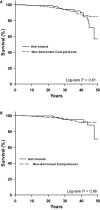Incidence Rate of Cardiovascular Disease End Points in the National Aeronautics and Space Administration Astronaut Corps
- PMID: 28784652
- PMCID: PMC5586420
- DOI: 10.1161/JAHA.117.005564
Incidence Rate of Cardiovascular Disease End Points in the National Aeronautics and Space Administration Astronaut Corps
Abstract
Background: It is unknown whether the astronaut occupation or exposure to microgravity influences the risk of long-term cardiovascular disease (CVD). This study explored the effects of being a career National Aeronautics and Space Administration (NASA) astronaut on the risk for clinical CVD end points.
Methods and results: During the Longitudinal Study of Astronaut Health, data were collected on 310 NASA astronauts and 981 nonastronaut NASA employees. The nonastronauts were matched to the astronauts on age, sex, and body mass index, to evaluate acute and chronic morbidity and mortality. The primary outcomes were composites of clinical CVD end points (myocardial infarction, congestive heart failure, stroke, and coronary artery bypass surgery) or coronary artery disease (CAD) end points (myocardial infarction and coronary artery bypass surgery). Of the astronauts, 5.2% had a clinical CVD end point and 2.9% had a CAD end point compared with the nonastronaut comparisons with 4.7% and 3.1% having CVD and CAD end points, respectively. In the multivariate models adjusted for traditional risk factors, astronauts had a similar risk of CVD compared with nonastronauts (adjusted hazard ratio, 1.08; 95% CI, 0.60-1.93; P=0.80). Risk of a CAD end point was similar between groups (hazard ratio, 0.97; CI, 0.45-2.08; P=0.93). In astronauts with early spaceflight experience, the risk of CVD (hazard ratio, 0.80; CI, 0.25-2.56; P=0.71) and CAD (hazard ratio, 1.23; CI: 0.27-5.61; P=0.79) compared with astronauts with no experience were not different.
Conclusions: These findings suggest that being an astronaut is not associated with increased long-term risk of CVD development.
Keywords: cardiovascular disease; heart failure; myocardial infarction; spaceflight; stroke.
© 2017 The Authors. Published on behalf of the American Heart Association, Inc., by Wiley.
Figures


References
-
- Convertino VA. Exercise and adaptation to microgravity environments. Compr Physiol 2011, Supplement 14: Handbook of Physiology, Environmental Physiology: 815–843. 1996. doi: 10.1002/cphy.cp040236 - DOI
-
- Dorfman TA, Levine BD, Tillery T, Peshock RM, Hastings JL, Schneider SM, Macias BR, Biolo G, Hargens AR. Cardiac atrophy in women following bed rest. J Appl Physiol. 2007;103:8–16. - PubMed
-
- Dorfman TA, Rosen BD, Perhonen MA, Tillery T, McColl R, Peshock RM, Levine BD. Diastolic suction is impaired by bed rest: MRI tagging studies of diastolic untwisting. J Appl Physiol. 2008;104:1037–1044. - PubMed
-
- Perhonen MA, Franco F, Lane LD, Buckey JC, Blomqvist CG, Zerwekh JE, Peshock RM, Weatherall PT, Levine BD. Cardiac atrophy after bed rest and spaceflight. J Appl Physiol. 2001;91:645–653. - PubMed
-
- Bungo MW, Goldwater DJ, Popp RL, Sandler H. Echocardiographic evaluation of space‐shuttle crewmembers. J Appl Physiol. 1987;62:278–283. - PubMed
MeSH terms
LinkOut - more resources
Full Text Sources
Other Literature Sources
Medical
Miscellaneous

